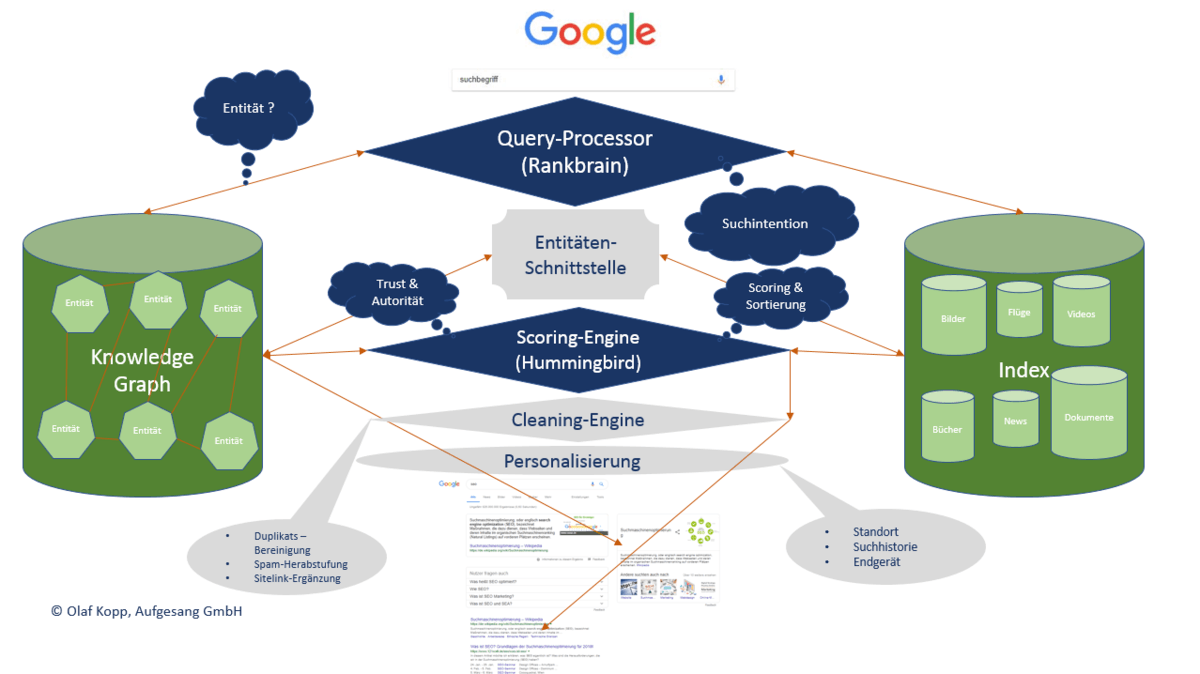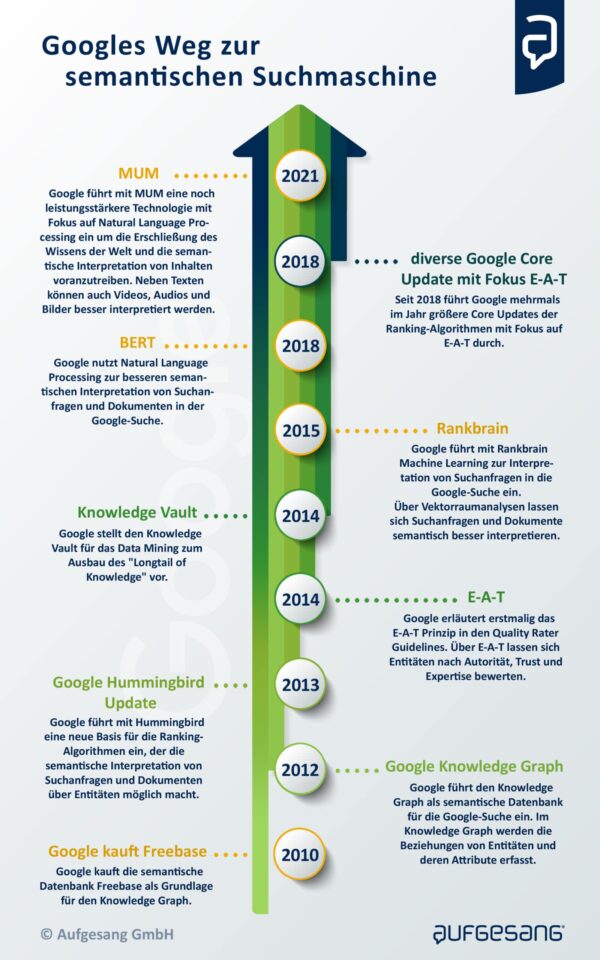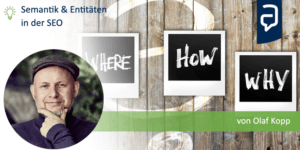Du interessierst Dich für das Google Hummingbird Update? Dann bist Du hier genau richtig. In diesem Beitrag bekommst Du alle wichtigen Informationen zu Google Hummingbird.
Inhaltsverzeichnis
Was ist Google Hummingbird?
Der Hummingbird-Algorithmus ist der aktuelle Ranking-Algorithmus von Google. Hummingbird zu deutsch Kollibri basiert auf einer semantischen Interpretation von Suchanfragen, Dokumenten und Autoritäten.

Retrieval & Scoring bei Google
Die Bedeutung von Hummingbird für Google
Die Einführung von Hummingbird zum 15. Geburtstag von Google im Jahr 2013 war der Startschuss der semantischen Suche. Google selbst hat dieses Algorithmus-Update als das bedeutenste seit dem Caffeine Update im Jahr 2010 bezeichnet.
Es soll zur Einführung ca. 90% aller Suchanfragen betroffen haben und war im Vergleich zu Caffeine ein echtes Algorithmus-Update. Es soll dabei helfen komplexere Suchanfragen besser zu deuten und noch besser die eigentliche Suchintention bzw. Fragestellung hinter einer Suchanfrage zu erkennen sowie passende Dokumente dazu anzubieten. Auch auf Dokumentenebene soll die eigentliche Intention hinter dem Content besser mit der Suchanfrage gematcht werden.
SEO-Experten-Stimmen aus der Branche zum Hummingbird Update
Danny Sullivan (damals Search Engine Land) hat live von der Google Pressekonferenz gebloggt. Hier einige Zitate:
Q&A. Hummingbird biggest revamp? Indeed, „it’s not easy to build a new algorithm that’s so good“
How’s it different? People asking more complicated questions. So how keep results so relevant in light of these. Hummingbird impact all types of queries we get but far more effective on these long queries we get now.
Indexing and ranking go hand in hand. Fundamentally, both these systems inpaced our ranking quiet a bit.
Gave us an oportunity, hummigbird did, to take synoyms and knwoledge graph and other things Google has been doing to understand meaning to rethink how we can use the power of all these things to combine meaning and predict how to match your query to the document in terms of what the query is really wanting and are the connections avialble in the doucuments. and not just random coincidence that could be the case in early search engins.
Wie bereits in unserem Beitrag Google-Ranking-Kriterien gestern, heute und Zukunft angemerkt wird der Knowledge Graph hier wohl eine zentrale Rolle spielen. Genauere Informationen gab es allerdings bisher nicht zum Hummingbird Update. Allerdings konnte sich Danny Sullivan nach der Pressekonferenz mit einigen Google-Mitarbeitern unterhalten und ein Schnell-FAQ veröffentlichen. Nachfolgend habe ich einige Punkte daraus zusammengefasst und übersetzt:
- Page Rank bzw. eingehende Links fließen auch weiterhin in den neuen Hummingbird-Algorithmus ein
- Hummingbird ist seit ca. einem Monat aktiv
- Hummingbird ist das größte Algorithmus-Update seit 2001
- Hummingbird hat den alten Algorithmus komplett ersetzt. Panda und Pinguin Update waren nur Teilerneuerungen des alten Algorithmus
- Hummingbird besteht aus Elementen des alten Algos und komplett neuen Elementen, die besser auf das aktuelle und zukünftige Suchverhalten ausgerichtet sind.
- Die wichtigste Aussage ist folgende: der Hummingbird-Algorithmus achtet zukünftig beim Matching zwischen Suchanfrage und Dokument weniger auf einzelne Keywords, sondern mehr darauf ob das Dokument die Frage hinter einer Suchwort-Kombination beantwortet. Auch mit Blick auf die zunehmende Nutzung der Voice Search ein wichtiger Schritt. Das Ganze auch unter Berücksichtigung von Standort und Endgerät, wie auch bereits im oben erwähnte Blogbeitrag zur Zukunft des Google-Rankings erwähnt.
- Google sind bisher keine größeren Traffic- bzw. Ranking-Verluste zumindest von großen Publishern aufgrund von Hummingbird bekannt und wenn man bis jetzt noch keine Traffic- oder Ranking-Verluste feststellen konnte solle man sich keine Sorgen machen.
Google might look at the query [What is the best place to find and eat Chicago deep dish style pizza?], and understand that a searcher looking for results for that query would likely be more satisfied with the use of “restaurant” instead of “place”. The use of “restaurant” instead of “place” might be considered as a potential synonym or substitute based upon substitution rules which focus upon co-occurring terms that might show up in search results when those terms are searched upon, or co-occurring terms in query sessions.
Die Rolle von Google Hummingbird für die semantische Suche
Das Humminbird Update steht zusammen mit dem Knowledge Graph für die Einführung der semantischen Suche bei Google. Der Hummingbird-Algorithmus bildet die fundamentale Basis, auf der Google den Weg zur semantischen Suchmaschine aufbaut.

Infografik: Googles Weg zur semantischen Suchmaschine
Die wichtigsten Google-Updates
Die Geschichte der Suchmaschinenoptimierung wurde maßgeblich durch die Weiterentwicklung der Suchmaschinen und insbesondere der Google-Updates geprägt. Die Updates mit dem größten Einfluss auf die Suchmaschinenoptimierung sind die Panda- und Pinguin-Update-Reihe, das Hummingbird-Update, das Exact Match Domain Update, Caffeine-Update und das Vince Update.
Seit 2015 gibt Google keine offiziellen Stellungnahmen zu Algorithmus-Updates mehr an. Hier eine Übersicht der offiziell bestätigten Google-Updates (Quelle: Sistrix)
| 2015 | Google Panda Update 4.2 |
| 2015 | Google Core Algorithmus Update (Phantom Update) |
| 2015 | Google Mobile-Friendly Ranking-Faktor Update |
| 2014 | Google Pirate Update 2.0 |
| 2014 | Google Penguin Update 3.0 |
| 2014 | Google Panda Update 4.1 |
| 2014 | Google HTTPS Ranking-Faktor Update |
| 2014 | Google Payday Loan 3.0 Update |
| 2014 | Google Panda Update 4.0 |
| 2014 | Google Payday Loan 2.0 Update |
| 2014 | Google Page Layout Update #3 (Ads Above The Fold) |
| 2013 | Google Penguin Update 2.1 |
| 2014 | Google Hummingbird Update |
| 2013 | Google Payday Loan Update |
| 2013 | Google Penguin Update 2.0 |
| 2012 | Google Page Layout Update #2 (Ads Above The Fold) |
| 2012 | Google Exact-Match Domain (EMD) Update |
| 2012 | Google DMCA Penalty |
| 2012 | Google Penguin Update |
| 2012 | Google Venice Update |
| 2012 | Google Page Layout Algorithm Update (Ads Above The Fold) |
| 2011 | Google Freshness Update |
| 2011 | Google Expanded Sitelinks Update |
| 2011 | Google Panda Update |
| 2010 | Google Caffeine Update |
| 2010 | Google May Day Update |
| 2009 | Google Vince Update (Brand Update) |
| 2008 | Google Dewey Update |
| 2007 | Google Buffy Update |
| 2005 | Google Big Daddy Update |
| 2005 | Google Jagger Update |
| 2005 | Google Gilligan Update |
| 2005 | Google Bourbon Update |
| 2005 | Google Allegra Update |
| 2004 | Google Brandy Update |
| 2004 | Google Austin Update |
| 2003 | Google Florida Update |
| 2003 | Google Fritz Update |
| 2003 | Google Esmeralda Update |
| 2003 | Google Dominic Update |
| 2003 | Google Cassandra Update |
| 2003 | Google Boston Update |
| 2002 | 1. dokumentiertes Google Update |
- Die Google Suche: So funktioniert das Ranking der Suchmaschine heute - 13. Februar 2024
- Die 11 interessantesten Google-Patente aus dem Jahr 2023 und die Auswirkungen auf SEO - 30. November 2023
- Sind LLMO, GAIO oder GEO die Zukunft von SEO? - 4. Oktober 2023
- Googles Weg zur semantischen Suchmaschine - 29. Juni 2023
- Digital Authority Management: Eine neue Disziplin in Zeiten von SGE & E-E-A-T - 29. Juni 2023
Blog-Artikel zu diesem Thema
Googles Weg zur semantischen Suchmaschine
 In diesem Beitrag möchte darauf eingehen welche Schritte und Innovationen Google seit 2010 näher an das Ziel des semantischen Verständnisses in der Suche gebracht haben. Es ist eine Zusammenfassung meiner Recherchen und Analysen seit 2013. Im Detail gehe ich auch auf die Rolle von Natural Languag... Artikel anzeigen
In diesem Beitrag möchte darauf eingehen welche Schritte und Innovationen Google seit 2010 näher an das Ziel des semantischen Verständnisses in der Suche gebracht haben. Es ist eine Zusammenfassung meiner Recherchen und Analysen seit 2013. Im Detail gehe ich auch auf die Rolle von Natural Languag... Artikel anzeigen
SEO-Aufgaben: Was macht ein SEO-Manager (m/w/d)?
 Suchmaschinenoptimierung hat sich in den letzten Jahren deutlich verändert. Dadurch auch die Arbeit für SEO-Manager und SEO-Verantwortliche. In diesem Beitrag möchte ich eine Übersicht über die wichtigsten Aufgaben eines(einer) SEO-Managers/in bei der taktischen und strategischen Suchmaschineno... Artikel anzeigen
Suchmaschinenoptimierung hat sich in den letzten Jahren deutlich verändert. Dadurch auch die Arbeit für SEO-Manager und SEO-Verantwortliche. In diesem Beitrag möchte ich eine Übersicht über die wichtigsten Aufgaben eines(einer) SEO-Managers/in bei der taktischen und strategischen Suchmaschineno... Artikel anzeigen
Die Dimensionen des Google-Rankings
 Die Rankingfaktoren bei Google sind über die Jahre immer mehrdimensionaler und vielfältiger geworden, was die die Suchmaschinenoptimierung immer komplexer erscheinen lässt. In diesem Artikel geht es um die Entwicklung der Ranking-Faktoren in der Suchmaschinenoptimierung (SEO) von der Dokumenten-E... Artikel anzeigen
Die Rankingfaktoren bei Google sind über die Jahre immer mehrdimensionaler und vielfältiger geworden, was die die Suchmaschinenoptimierung immer komplexer erscheinen lässt. In diesem Artikel geht es um die Entwicklung der Ranking-Faktoren in der Suchmaschinenoptimierung (SEO) von der Dokumenten-E... Artikel anzeigen
Sind Nutzersignale wie CTR, Absprungrate oder Verweildauer ein Rankingfaktor?
 Der große Einfluss der Nutzersignale auf das Ranking ist in der SEO-Branche unumstritten und für die meisten SEO-Experten sind die Nutzersignale der heilige Gral. Doch sind Nutzersignale wirklich ein Rankingfaktor? Dieser Beitrag beschäftigt sich kritisch mit dieser Theorie und soll darüber ... Artikel anzeigen
Der große Einfluss der Nutzersignale auf das Ranking ist in der SEO-Branche unumstritten und für die meisten SEO-Experten sind die Nutzersignale der heilige Gral. Doch sind Nutzersignale wirklich ein Rankingfaktor? Dieser Beitrag beschäftigt sich kritisch mit dieser Theorie und soll darüber ... Artikel anzeigen
Wie versteht Google Suchanfragen durch Search Query Processing?
 Dieser Beitrag meiner Artikelreihe zu Semantik und Entitäten in der SEO und bei Google beschäftigt sich mit der Rolle von Entitäten bei der Interpretation von Suchanfragen. Dabei werde ich auf einige Google Patente der letzten Jahre eingehen und daraus Ableitungen für das Search Query Processing... Artikel anzeigen
Dieser Beitrag meiner Artikelreihe zu Semantik und Entitäten in der SEO und bei Google beschäftigt sich mit der Rolle von Entitäten bei der Interpretation von Suchanfragen. Dabei werde ich auf einige Google Patente der letzten Jahre eingehen und daraus Ableitungen für das Search Query Processing... Artikel anzeigen
Entitäten-basierte Indexierung: Vom Content-Index zum Entitäten-Index
 Die Basis für das Google-Ranking waren bis 2013 Websites, deren Content, Keywords und Backlinks. Mit dem Hummingbird-Update und dem Google Knowledge Graph startete Google die eigene Transformation zur semantischen Suchmaschine. Entitäten spielen bei dieser Transformation mit Blick auf die Indexier... Artikel anzeigen
Die Basis für das Google-Ranking waren bis 2013 Websites, deren Content, Keywords und Backlinks. Mit dem Hummingbird-Update und dem Google Knowledge Graph startete Google die eigene Transformation zur semantischen Suchmaschine. Entitäten spielen bei dieser Transformation mit Blick auf die Indexier... Artikel anzeigen
Wie schlau ist Google? Echtes semantisches Verständnis oder nur Statistik?
 Dies ist der vierte Teil einer Beitragsreihe zum Thema semantische SEO und behandelt die Frage, ob Google wirklich die Bedeutung von Dokumenten und Suchanfragen versteht oder es doch nur statistische Analysen deutet.
Semantisches Verständnis als Ziel von Google
Eines der wichtigsten Ziele von Goo... Artikel anzeigen
Dies ist der vierte Teil einer Beitragsreihe zum Thema semantische SEO und behandelt die Frage, ob Google wirklich die Bedeutung von Dokumenten und Suchanfragen versteht oder es doch nur statistische Analysen deutet.
Semantisches Verständnis als Ziel von Google
Eines der wichtigsten Ziele von Goo... Artikel anzeigen
Video: Entitäten basierte Suche – Alles zum Knowledge Graph, NLP, Ranking, E A T und Semantik in der SEO
 Im April 2020 habe ich für den OMT ein knapp zweistündiges Webinar zum Thema Semantische Suche bzw. Entitäten basierte Suche gehalten. Ich beschreibe ausführlich den Zusammenhang zwischen Knowledge-Graph, Data-Mining via Natural-Language-Processing und wie das Ganze mit E-A-T und digitalen Marke... Artikel anzeigen
Im April 2020 habe ich für den OMT ein knapp zweistündiges Webinar zum Thema Semantische Suche bzw. Entitäten basierte Suche gehalten. Ich beschreibe ausführlich den Zusammenhang zwischen Knowledge-Graph, Data-Mining via Natural-Language-Processing und wie das Ganze mit E-A-T und digitalen Marke... Artikel anzeigen
Aufzeichnung: Semantische Suche bei Google – SEO/SEA World Conference / Internet World
 Aufzeichnung meines Vortrags auf der SEO/SEA World Conference 2021 präsentiert von der Internet World.
Google entwickelt sich seit der Einführung des Knowledge Graph und Hummingbird immer mehr zu einer semantischen Suchmaschine. Die Einführung von DeepRank (BERT) und MUM hat diesen Prozess z... Artikel anzeigen
Aufzeichnung meines Vortrags auf der SEO/SEA World Conference 2021 präsentiert von der Internet World.
Google entwickelt sich seit der Einführung des Knowledge Graph und Hummingbird immer mehr zu einer semantischen Suchmaschine. Die Einführung von DeepRank (BERT) und MUM hat diesen Prozess z... Artikel anzeigen
Wie kann Google über Entitäten, NLP & Vektorraumanalysen relevante Dokumente identifizieren und ranken?
 Dieser Beitrag meiner Artikelreihe zu Semantik und Entitäten in der SEO beschäftigt sich damit wie Google für Suchanfragen mit Entitäten-Bezug u.a. über Natural Language Language Processing und Vektorraumanalysen passende Inhalte identifiziert und rankt. Dazu habe ich über 20 Google-Patente un... Artikel anzeigen
Dieser Beitrag meiner Artikelreihe zu Semantik und Entitäten in der SEO beschäftigt sich damit wie Google für Suchanfragen mit Entitäten-Bezug u.a. über Natural Language Language Processing und Vektorraumanalysen passende Inhalte identifiziert und rankt. Dazu habe ich über 20 Google-Patente un... Artikel anzeigen
Bedeutung von Machine Learning, AI & Rankbrain für SEO & Google
 Machine Learning und Artificial Intelligence (AI) nehmen einen immer größeren Raum bei der Modellierung und Klassifizierung nach Mustern auch im Online Marketing ein. Unternehmen wie z.B. Tesla, Google, Microsoft, Amazon und Facebook betreiben großen Forschungsaufwand im Bereich der künstlich... Artikel anzeigen
Machine Learning und Artificial Intelligence (AI) nehmen einen immer größeren Raum bei der Modellierung und Klassifizierung nach Mustern auch im Online Marketing ein. Unternehmen wie z.B. Tesla, Google, Microsoft, Amazon und Facebook betreiben großen Forschungsaufwand im Bereich der künstlich... Artikel anzeigen
Das semantische Web (Web 3.0) als logische Konsequenz aus dem Web 2.0
 Die Entwicklung hin zum semantischen Web verändert die Priorisierung und Auslieferung von Informationen durch die wichtigsten Gatekeeper im Netz und damit auch das Online-Marketing. Nachfolgend ein Erklärungsansatz.
Das Web 3.0 als logische Konsequenz aus dem Web 2.0
Das Web 2.0 m... Artikel anzeigen
Die Entwicklung hin zum semantischen Web verändert die Priorisierung und Auslieferung von Informationen durch die wichtigsten Gatekeeper im Netz und damit auch das Online-Marketing. Nachfolgend ein Erklärungsansatz.
Das Web 3.0 als logische Konsequenz aus dem Web 2.0
Das Web 2.0 m... Artikel anzeigen
Happy Hash-Tagging bei Google! Semantische Verbindung von Inhalten und Entitäten
 Das #Hashtag ist ein Internetdings mit einer wichtigen Funktion. Es dient der Verschlagwortung von Inhalten und kann als solches ein wenig Ordnung in die digitale Informationsflut bringen. Wobei „Ordnung“ relativ gemeint ist.
Man könnte sie eher als eine Art roten Faden im Informationsch... Artikel anzeigen
Das #Hashtag ist ein Internetdings mit einer wichtigen Funktion. Es dient der Verschlagwortung von Inhalten und kann als solches ein wenig Ordnung in die digitale Informationsflut bringen. Wobei „Ordnung“ relativ gemeint ist.
Man könnte sie eher als eine Art roten Faden im Informationsch... Artikel anzeigen
Branding & das neue Google Ranking: Warum SEO nicht mehr reicht…
 Das Etablieren einer Marke wird zukünftig eine immer wichtigeree Rolle beim Ranking von Inhalten spielen. Warum die Suchmaschinenoptimierung (SEO) bei der Beeinflussung der Suchmaschinen-Rankings nur noch eine Aufgabe dabei ist und Marketing immer wichtiger erläutere ich nachfolgend.
&n... Artikel anzeigen
Das Etablieren einer Marke wird zukünftig eine immer wichtigeree Rolle beim Ranking von Inhalten spielen. Warum die Suchmaschinenoptimierung (SEO) bei der Beeinflussung der Suchmaschinen-Rankings nur noch eine Aufgabe dabei ist und Marketing immer wichtiger erläutere ich nachfolgend.
&n... Artikel anzeigen
Google achtet jetzt auf innere Werte
 2013 hat Google sich zum 15. Geburtstag ein ganz besonderes Geschenk gemacht. Die Suchmaschine hat einen Vogel, einen Kolibri, um genau zu sein und der wirbelt den Tiergarten nicht nur farblich auf. Es handelt sich dabei nämlich nicht um ein Anti-Spam-Update á la Panda oder Pinguin, mit dem die S... Artikel anzeigen
2013 hat Google sich zum 15. Geburtstag ein ganz besonderes Geschenk gemacht. Die Suchmaschine hat einen Vogel, einen Kolibri, um genau zu sein und der wirbelt den Tiergarten nicht nur farblich auf. Es handelt sich dabei nämlich nicht um ein Anti-Spam-Update á la Panda oder Pinguin, mit dem die S... Artikel anzeigen






